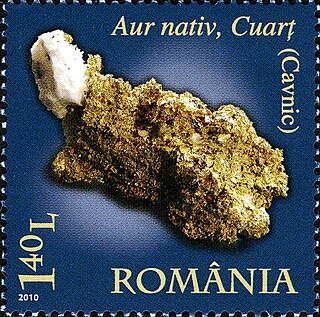Related Research Articles

Mining in Iran is still under development, yet the country is one of the most important mineral producers in the world, ranked among 15 major mineral-rich countries, holding some 68 types of minerals, 37 billion tonnes of proven reserves and more than 57 billion tonnes of potential reserves worth $770 billion in 2014. Mineral production contributes only 0.6 percent to the country's GDP. Add other mining-related industries and this figure increases to just four percent (2005). Many factors have contributed to this, namely lack of suitable infrastructure, legal barriers, exploration difficulties, and government control.

Mining in the United Kingdom produces a wide variety of fossil fuels, metals, and industrial minerals due to its complex geology. In 2013, there were over 2,000 active mines, quarries, and offshore drilling sites on the continental land mass of the United Kingdom producing £34bn of minerals and employing 36,000 people.
The Telfer Mine is a gold, copper and silver mine located at Telfer on the land of the Martu people, in the Great Sandy Desert of Western Australia. It is owned by Newmont, having acquired the previous owner, Newcrest Mining, formerly the largest gold producer listed on the Australian Securities Exchange, in November 2023.

The Cavnic mine is a large mine located in the northwest of Romania in Maramureș County, 26 km southwest of Baia Mare and 576 km north of the capital, Bucharest. Cavnic represents one of the largest polymetallic reserves in Romania having significant reserves of gold, silver, copper, lead and zinc amounting to 20 million tonnes of ore grading 1g/t gold, 30g/t silver, 2% lead, 3% zinc and 1% copper. The resources amount to 640,000 oz of gold, 19.2 million oz of silver, 400,000 tonnes of lead metal, 600,000 tonnes of zinc metal, and 200,000 tonnes of copper metal.
The Colnic mine is a large open pit mine in the west of Romania in Hunedoara County, 30 km north of Deva and 400 km north of the capital, Bucharest. Colnic represents a large gold and copper deposit with estimated reserves of 2.15 million oz of gold and 135,000 tonnes of copper. The project is owned by the Toronto-based company Carpathian Gold.
The Cireșata mine is a large open pit mine in the west of Romania in Hunedoara County, 30 km (19 mi) north of Deva and 400 km (250 mi) northwest of the capital, Bucharest. Cireșata represents a large gold and copper deposit with estimated reserves of 4.18 million oz of gold and 174.4 million tonnes of copper ore grading 0.15% copper. The project is owned by the Toronto-based company Carpathian Gold.
The Qaf-Buall mine is a large mine located in central Albania in Dibër County, 40 kilometres (25 mi) east of the capital, Tirana. Qaf-Buall represents one of the largest chromium reserve in Albania and one of the largest in Europe having estimated reserves of 1.5 million tonnes of ore grading 39.44% chromium metal. The mine is part of the Bulqizë Massif, a 370 square kilometres (140 sq mi) area which has a rock thickness between 4 kilometres (2.5 mi) and 6 kilometres (3.7 mi) and contains 65 verified chromium deposits and occurrences. The deposit has been explored to depths of up to 1,300 metres (4,300 ft) and the geological reserves amount to 12 million tonnes of which 7.5 million tonnes grading over 38% chromium metal.
{{Infobox mine | name = Krasta mine | image = | width = | caption = | pushpin_map = Albania | pushpin_label = Krasta mine | pushpin_map_caption = Location in Albania | coordinates = 41°25′51″N20°12′33″E | place = Krastë | subdivision_type = County | state/province = Dibër County | country = Albania | owner = [[Public company | official website = | acquisition year = | products = Chromium | financial year = | amount = | opening year = 1942 | closing year = 2006 }} The Krasta mine is a large mine located in central east Albania, adjacent to the town of Krastë in Dibër County, 40 kilometres (25 mi) as the crow flies, east of the capital, Tirana. Krasta represents one of the largest chromium reserves in Albania and in all Europe, having estimated reserves of 2 million tonnes of ore grading 40% chromium metal.
The Batra mine is a large chromium mine located in central Albania in Dibër County, 40 kilometres (25 mi) east of the capital, Tirana. Batra represents one of the largest chromium reserve in Albania and one of the largest in Europe, having estimated reserves of 0.73 million tonnes of ore grading 38% chromium metal. The mine is part of the Bulqizë Massif, a 370 square kilometres (140 sq mi) area which has a rock thickness between 4 kilometres (2.5 mi) and 6 kilometres (3.7 mi) and contains 65 verified chromium deposits and occurrences. The deposit has been explored to depths of up to 1,560 metres (5,120 ft) and the geological reserves amount to 12 million tonnes of which 7.5 million tonnes grading over 38% chromium metal.
The Thekna mine is a large mine located in central Albania in Dibër County, 40 kilometres (25 mi) east of the capital, Tirana. Thekna represents one of the largest chromium reserve in Albania and one of the largest in Europe having estimated reserves of 0.652 million tonnes of ore grading 38% chromium metal. The mine is part of the Bulqizë Massif, a 370 square kilometres (140 sq mi) area which has a rock thickness between 4 kilometres (2.5 mi) and 6 kilometres (3.7 mi) and contains 65 verified chromium deposits and occurrences. The deposit has been explored to depths of up to 1,560 metres (5,120 ft) and the geological reserves amount to 12 million tonnes of which 7.5 million tonnes grading over 38% chromium metal.
The Divriği A-Kafa mine is a large mine in the east of Turkey in Sivas Province 245 km east of the capital, Ankara. Divriği A-Kafa represents the largest iron reserve in Turkey having estimated reserves of 100 million tonnes of ore grading 55% iron. The 100 million tonnes of ore contains 55 million tonnes of iron metal.
The Divriği B-Kafa mine is a large mine in the east of Turkey in Sivas Province 245 km east of the capital, Ankara. Divriği B-Kafa represents the largest iron reserve in Turkey having estimated reserves of 50 million tonnes of ore grading 55% iron. The 50 million tonnes of ore contains 27.5 million tonnes of iron metal.
The Çakmakkaya mine is a large mine in the east of Turkey in Artvin Province 465 km east of the capital, Ankara. Çakmakkaya represents one of the largest copper reserve in Turkey having estimated reserves of 100 million tonnes of ore grading 0.8% iron. The 100 million tonnes of ore contains 800,000 tonnes of copper metal.
The Damar mine is a large mine in the east of Turkey in Artvin Province, 465 km east of the capital, Ankara. Damar represents one of the largest copper reserves in Turkey having estimated reserves of 15 million tonnes of ore grading 1.11%. The 15 million tonnes of ore contains 167,000 tonnes of copper metal.
The Çayeli mine is a large mine in the east of Turkey in Rize Province 470 km east of the capital, Ankara. Çayeli represents one of the largest copper reserve in Turkey having estimated reserves of 20 million tonnes of ore grading 2.5% copper. The 20 million tonnes of ore contains 500,000 tonnes of copper metal.
The Avnik mine is a large iron ore mine in Bingöl Province, eastern Turkey, 728 km (452 mi) east of the capital, Ankara.
The Tirebolu mine is a large mine in the north of Turkey in Giresun Province, 517 km north of the country's capital, Ankara. Tirebolu represents one of the largest copper reserve in Turkey having estimated reserves of 8.6 million tonnes of ore grading 3% copper and 2% zinc. This translates to 260,000 tonnes of copper metal and 172,000 tonnes of zinc metal.
The Altân Tepe mine was a large mine in the east of Romania in Tulcea County, 63 km southwest of Tulcea and 215 km north-east of the capital, Bucharest. Altân Tepe represents the third largest copper reserve in Romania having estimated reserves of 200 million tonnes of ore grading 0.4% copper. After operation for 105 years, it was closed and conserved in 2003 due to nonprofitability. It had also problems with water contamination.
Mining in North Korea is important to the country's economy. North Korea is naturally abundant in metals such as magnesite, zinc, tungsten, and iron; with magnesite resources of 6 billion tonnes, particularly in the North and South Hamgyong Province and Chagang Province. However, often these cannot be mined due to the acute shortage of electricity in the country, as well as the lack of proper tools to mine these materials and an antiquated industrial base. Coal, iron ore, limestone, and magnesite deposits are larger than other mineral commodities. Mining joint ventures with other countries include China, Canada, Egypt, and South Korea.
The Cevizlidere mine is a large copper mine located in Tunceli Province in eastern Turkey. Cevizlidere represents one of the largest copper reserves in Turkey, with estimated reserves of 445.7 million tonnes of ore grading 0.38% copper.
References
- 1 2 "Geochemical proximity indicators" (PDF). jeotermal.sdu.edu.tr. 2010. Archived from the original (PDF) on 2010-03-26. Retrieved 2010-10-02.
